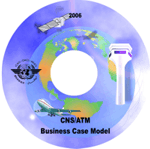Guidance
Economic aspects of air navigation facilities and services can be suitably assessed by analysing their costs and benefits to users and providers in relation to the investment requirements. ICAO developed guidance material to that extent and recommended its Contracting States to conduct a cost-benefit analysis as part of drawing an implementation plan for satellite-based communications, navigation and surveillance/air traffic management (CNS/ATM) systems, if and when required. Making cost-benefit studies part of the planning process will enable States to identify cost-effective technical solutions, favourable institutional arrangements and timing of implementation options. The development of a related business case is a complementary planning tool to explore possibilities and limitations of financing schemes, including capital needs, user fee structures and cash flow demands.
|
A cost-benefit model is described in Economics of Satellite-based Air Navigation Services, Guidelines for cost-benefit analysis of CNS/ATM systems (Circular 257). The model is based on a comparison of costs associated with implementing the new CNS/ATM systems (the project case) with those of maintaining the existing present-technology systems in the long term (the base case). The model uses a widely accepted approach, namely Net Present Value (NPV) of life-cycle. It focuses on discounted annual cash flows, representing the costs and benefits of CNS/ATM systems over a given implementation period. Click here (pfd) for a preview. |
| Estimating costs and benefits, and hence the NPV, of future CNS/ATM systems requires many assumptions about prices and quantities of communications, navigation and surveillance equipment on which the configuration of the future system can be based. Other assumptions need to be made about associated air navigation services and potential savings in aircraft operating costs which are attributable to the enhanced operational efficiency of the satellite-based systems. Generally, it is recommended that these assumptions be developed in consultation with experts from equipment manufacturers, service providers, and aircraft operators |
Sound air navigation systems planning requires also forecasting techniques and meaningful statistical data as some costs or benefits will depend on the anticipated volume of air traffic, both in the airspace and at airports. For example, satellite communication services are usually purchased on a usage basis. Thus, assumed expenditures on these services are calculated by the volume of messages transmitted which, in turn, will depend on the traffic volume. Potential savings in aircraft operating costs will also depend on the traffic density in the airspace.
|  |
For the purpose of cost-benefit analyses, traffic volume is measured by the hours flown annually by aircraft in a given airspace. Total hours flown are equal to the number of flights multiplied by the average duration per flight in the airspace concerned. Normally, the forecast number of flights is derived from passenger traffic forecasts.
|
CNS/ATM Business Case Analysis Tool (DFACS)
A computer application has been developed by ICAO in support of the implementation of CNS/ATM systems. The CNS/ATM Database and Financial Analysis Computer System (DFACS) model is an interactive, analytical tool that enables air navigation service providers (ANSPs) and airspace users to build, evaluate and compare the economics of alternative options or scenarios for the implementation of CNS/ATM systems. A CD-ROM containing the computer application along with a User’s Manual and an illustrative example has been made available. States may download the application and the documents from the ICAONET website (Electronic publications/ ICAO documents). Other users may purchase the CD-ROM.
